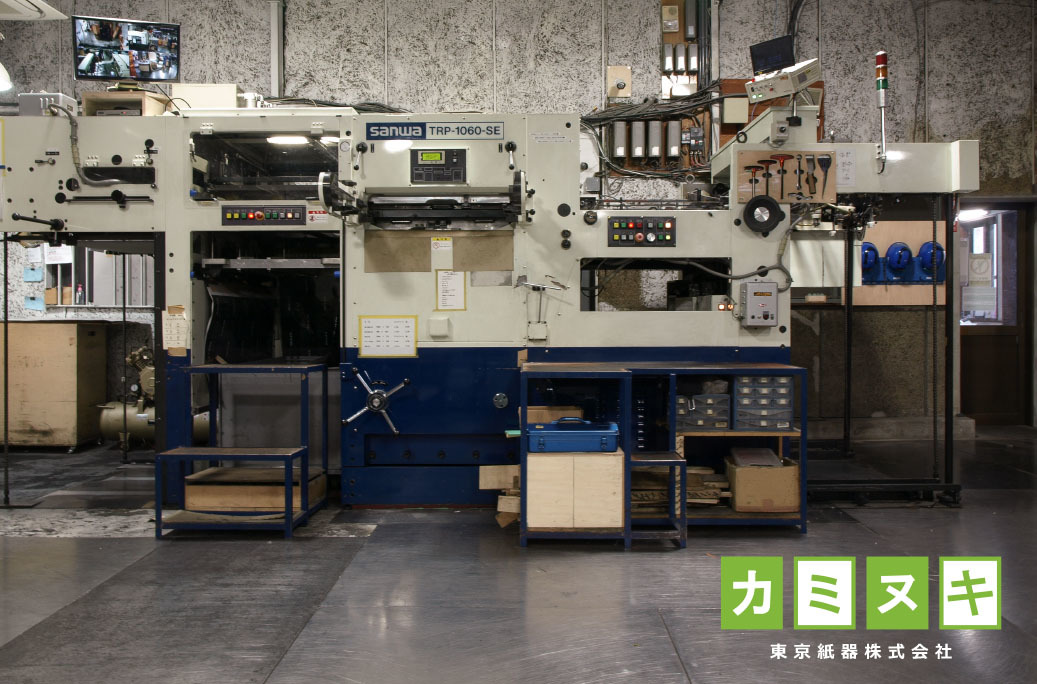
Ladies and gentlemen, the fruitful autumn season has arrived. In the printing industry, there are seasons of slow and busy periods, and I believe the peak for paper processing and commercial printing often falls in autumn. There is no end to the list: calendars move in large volumes, projects aimed for the next fiscal year starting in April begin to roll out, and promotional materials for the end of the year and the New Year, not to mention items for Valentine’s Day, are already on the move.
The second installment is about the Automatic Flatbed Die-Cutting Machine. We will briefly explain the machine that our company primarily uses for die-cutting processes.
What is an Automatic Flatbed Die-Cutting Machine?
The Automatic Flatbed Die-Cutting Machine is one of the machine types introduced in the first installment, known as a ‘Platen Die-Cutting Machine’.
The Automatic Flatbed Die-Cutting Machine, commonly referred to as ‘Auton,’ is used for die-cutting in a wide range of fields, including commercial and publication printing, packaging, and cardboard. ‘Auton’ is said to be an abbreviation for an automated (auto) Thomson die-cutter. ‘Thomson’ is believed to originate from the American Thomson Machine Company, which started manufacturing such mechanism machines, and the dies used in Thomson die-cutting are called ‘Thomson dies’. Thomson die-cutting involves using these Thomson dies and applying flat pressure through an up-and-down motion to die-cut, while Auton refers to machines that automate this process.
The Structure of an Auton
The Auton fundamentally consists of four main parts: the feeder, the die-cutting section (platen), the stripper, and the delivery. After setting full-sheet paper on a pallet or similar platform into the feeder, the paper is first lifted by suction cups, also known as ‘tacos’, and then fed into the machine.
After being fed into the machine, the paper flows at a constant speed between the feeder and the die-cutting section, in a sashimi-like state. When it reaches just before the die-cutting section, it is grabbed by grippers and pulled quickly to the die-cutting area. If the paper is too thin, this pulling force can cause the paper to warp, preventing successful die-cutting. To avoid this, the speed is adjusted, but as a result, the die-cutting processing speed will decrease.
The paper that enters the die-cutting section is processed by being pressed against the mold with strong pressure (up to about 300 tons). The mold is pre-set in a mechanism called a chase and is fixed facing downwards. The paper is then pressed upwards against it.
The processed paper is then sent by the grippers to the stripping section, where it momentarily stops to drop the unwanted parts of the sheet. A special stripping die is required for the stripping section. After the stripping is completed, the paper is sent to the delivery section and ejected.
The Characteristics of an Auton
The distinguishing feature of the Automatic Flatbed Die-Cutting Machine lies in its high versatility. It can process a wide range of papers, from approximately 46/70gsm (over 90gsm for coated paper) to a maximum thickness of about 3mm (1.5mm for machines owned by Tokyo Shiki), enabling the processing of various papers ranging from posters and calendars to thick materials like cardboard.
Furthermore, it can handle a wide range of paper sizes, from A3 to K-size, and not only single-sided items but also large-format multi-up items with ease. Additionally, it boasts high productivity, running at over 4,000 revolutions per hour depending on conditions and machine specifications.
As for its drawbacks, it cannot process small-sized sheets or thin papers below 70gsm, and due to its large size, setup operations are cumbersome, making it unsuitable for processing extremely small batches. For situations requiring processing of small-sized paper or small batches, it is advisable to use a Victoria (Vic). Additionally, even thin papers that cannot be processed by the Auton may be processed using cylinder-type die-cutting machines like Heidelberg (no such facility exists within Tokyo Shiki).
Introduction to Our Facilities
Finally, let me introduce our Auton equipment located within our company. We have four Auton machines, capable of die-cutting from a minimum size of 400×275mm to a maximum size of 950×1,300mm. In terms of paper size, we can process from A3 to double A size.
Additionally, although not Auton machines, we also have semi-automatic die-cutting machines, which enables us to accommodate a wide variety of processing needs.
Over the years, we have been engaged in die-cutting operations, handling various types of die-cutting projects including one-off assignments. If you’re looking to process paper, please feel free to contact us. We can provide suggestions and take care of everything from printing to delivery.
This time, we introduced the Automatic Flatbed Die-Cutting Machine (Auton). Next time, we’ll talk about ‘dies’. Stay tuned!
